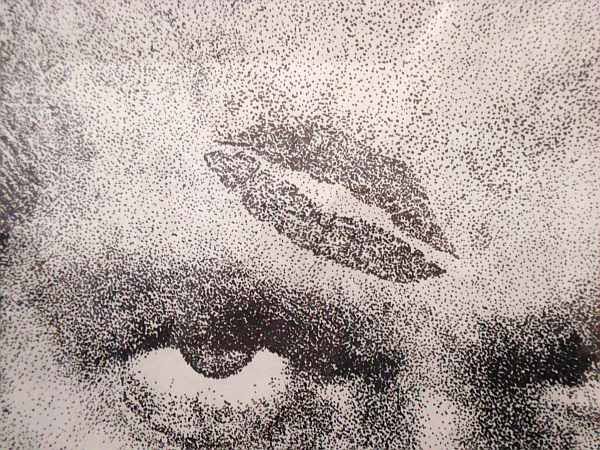Laura Lark painstakingly draws screen idols Steve McQueen and Jane Fonda with tiny dots. The technique is similar to the early works of Drew Friedman, but Friedman was primarily concerned with drawing celebrities who were at best not conventionally attractive and more usually downright ugly. (one notable exception was 1989's "I, Joey Heatherton," which mocked Hollywood's sex-symbol machinery). Lark's stars in this show are by contrast glamorous and attractive.

Laura Lark, Cover, ink marker on Tyvek, 43 x 33 inches, 2011

Laura Lark, Cover detail, ink marker on Tyvek, 43 x 33 inches, 2011
There is no drawing technique more tedious than stippling. (Friedman, its master, eventually abandoned it.) But the obsessive nature of the technique could be seen as parallel to the obsessions people have about movie stars. People build shrines to stars, cover their walls with their images. They take the place in secular society of saints or pantheons of gods. (And sometimes movie stars exist alongside saints or gods.)
I usually don't talk to the artists before I review their work, but this time, more-or-less by accident, I ended up having an email exchange about her show, The Livable Forest. Her starting point had been the myth of Diana and Actaeon (mortal hunter Actaeon accidentally discovers Diana bathing nude. She turns him into a deer and he is subsequently hunted and killed by his fellow hunters.) The wall pieces are places within a silvery forest installation.

Laura Lark, Livable Forest installation view
The pile of silver bricks in the foreground is called Ruin. Behind it to the left is Jane, taken from a photo of Jane Fonda at age 16 wielding a bow. To the right is an image of Steve McQueen called Cover. The obvious way to read it in terms of the myth is that Steve McQueen is Actaeon, Jane Fonda is Diana. (McQueen died in 1980 after an operation to try to slow his terminal cancer.) But that doesn't quite work. The whole thing about Actaeon is that he is a mortal--a lesser being--who has seen a goddess. McQueen is as much a god as Fonda. And gods who transgress may be punished, but they don't die (only Pan has died).

Laura Lark, Siren, hand-applied aluminum leaf over acrylic and brick, 40 x 31 x 20 inches, 2011
Instead it feels like The Livable Forest is a sacred grove, a place where we mortals go to worship immortals like Jane and Steve. But Steve is not really immortal. Screen idols can die.

Laura Lark, Dreamy Steve, ink marker on Tyvek, 43 x 33 inches, 2011

Laura Lark, Dreamy Steve (detail), ink marker on Tyvek, 43 x 33 inches, 2011
One of Nicolas Poussin's most famous paintings--and most moving to me--is Et en Arcadia Ego. It depicts a group of shepherds discovering a tomb (on which "Et en Arcadia Ego" is inscribed). It refers to Arcadia as a kind of utopian place, but despite this, death is still present. The tomb is quoting death, saying "Even in Arcadia, I exist." But one shepherd is tracing the outline of another shepherd's silhouette on the tomb. This is the mythological origin of art, and it is also therefore seen as a way to get around death. Death after the invention of art is no longer oblivion--its victims are remembered through painting, drawing, poetry, etc. Art makes both the subjects and creators immortal.
Actaeon may have looked at the wrong goddess and got himself killed. But Ovid and Aeschylus and Titian and many others have sure that he will never be forgotten. And a series of Hollywood producers and directors make certain that Steve McQueen will never die--as long as we keep watching The Great Escape, Nevada Smith, Bullitt, The Getaway and many other badass movies.
The thing is, I don't think Laura Lark really intended this meaning. I've come along with an interpretation that just wasn't there before I made it up. I do this all the time, it seems. So my apologies to Laura Lark and all the artists who have suffered through my spurious readings of their work.
The Livable Forest can be seen at Devin Borden Gallery.




No comments:
Post a Comment